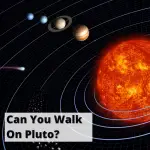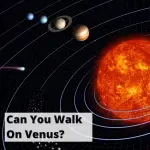Yes, it is possible for a human to walk on Mercury.
In the following article, we’ll explain.
Can You Walk On Mercury? (EXPLAINED)
Introduction To Mercury
Mercury is the planet in our solar system that orbits closest to the sun.
It is also the smallest planet of the 8 planets in our solar system.
Mercury is called a “terrestrial planet” and it is one of four terrestrial planets on our solar system (Mercury, Venus, Earth, and Mars).
It has a solid composition (in contrast with the gas giants and ice giants that do not possess a firm or solid surface upon which to land or walk).
It is believed that the core of Mercury is made of iron, and the remainder of the mantle and crust are metallic materials and silicates.
Why Can You Walk On Mercury?
Let’s put aside temperature, radiation, and travel to Mercury, and focus on the basics of landing on Mercury and walking there.
The primary reason a spacewalk on Mercury is possible (as compared to Jupiter, Saturn, Neptune, and Uranus) is that the planet has a solid surface.
Next, walking on Mercury is possible because the gravity isn’t astronomical.
In fact, Mercury’s gravity is in the range of 35-40% of Earth.
This means that someone who weighs 200lbs on Earth would weigh about 70-80lbs on Mercury.
If you were to land on Mercury, your ship wouldn’t crumple due to the forces, nor would you die quickly because of the pressure on your body.
Walking would look a bit like bouncing or hopping unless you added some weight to hold you more firmly on the surface.
Surviving a spacewalk on Mercury would depend upon whether you had the technology to survive the heat as well as the radiation.
Mercury is really close to the sun.
If you are standing on Mercury, the temperatures of the surface could be extremely hot, especially if you are on a part of the planet facing the sun.
The surface temperature ranges from -170 degrees Celsius (when facing away) to upwards of over 400 degrees Celsius (when facing the sun).
That’s upward over 800 degrees Fahrenheit.
Next, Mercury doesn’t have enough gravity to hold an atmosphere.
Instead, solar winds grind off atoms (oxygen, hydrogen, helium and others) from the surface of the planet and meteoroids that have crashed into it, and the weak gravity hangs onto them.
We call this thin layer Mercury’s “exosphere.”
Mercury’s thin exosphere does little to protect the small rocky planet from the solar radiation of the sun, as Earth’s atmosphere does.
Mercury is thought to receive more than 7 times the amount of radiation to its surface than Earth does.
Depending on the technology you are wearing while traveling to Mercury and walking on Mercury, the radiation might not be an issue.
Finally, to take a walk on Mercury, you’d need to bring all your own breathable air.
An astronaut would be most likely to survive a hike on the dark side of the planet (facing away from the sun) where she wouldn’t have to face the extreme heat or radiation, or in the polar regions.
Did You Know? (Other Facts About Mercury)
Here are some facts you may not have known about Mercury:
- While Mercury is the smallest planet in our solar system, it is still twice the size of Pluto (classified as a dwarf planet).
- It takes Mercury only 88 Earth days to orbit the sun one time. Contrast that with Pluto, which takes about 248 Earth years to make it around the sun just one time. Uranus takes 84 Earth years, while Jupiter takes a 12 Earth years.
- While Mercury travels around the sun quickly, it rotates rather slowly. It takes over 58 Earth days to fully rotate one time.
- Mercury is slowly shrinking. The prevailing theory is that the planet’s core is slowly cooling, contracting as it does so.
- Mercury has no moons. The only other planet in our solar system that has no moons is Venus.
- Mercury is pretty close to Earth, and has been visible with the naked eye since the times when people started to pay attention to such things. There’s no official “discovery date” associated with Mercury, as it seems to have always just been there.
- Even though Mercury can be scorching hot, water ice has been discovered in craters around Mercury’s north pole.
- Scientists believe that Mercury is active geologically. Though there isn’t much evidence of any active volcanic activity, there is evidence of ground shaking quakes.
- Mercury has a magnetic field, which surprised scientists. Generally, a magnetic field is associated with planets that spin quickly enough.
- NASA purposefully crashed the Messenger orbiter onto the surface of Mercury when it ran out of fuel in 2015 to observe the results.
- Mercury has no rings.
- While Mercury is the planet closest to the sun, it is not the hottest planet. Venus is actually the hottest planet in our solar system. The reason is that Mercury doesn’t have enough gravity to hold onto an atmosphere, while Venus does. The layer around Venus traps the heat around the planet, while any heat around Mercury is free to dissipate into open space.
- While Mercury doesn’t have any moons, over 700 craters on the surface of the planet have been catalogued. Many of them have been given names, many of which are authors, poets, and painters (Clarence Beckett, Ivan Bunin, Charles Dickens, Hesiod, Lu Xun, Mark Twain, and more).
- Mercury’s lack of atmosphere means that the planet does not experience storms like we see on Mars, Jupiter, Saturn, and Neptune. There’s no clouds, no wind (aside from solar wind), or precipitation of any kind.
Wrap Up
Mercury is a fascinating planet, and we look forward to learning more about it as the progress of space exploration continues.
You might also enjoy:






